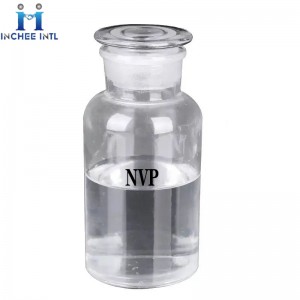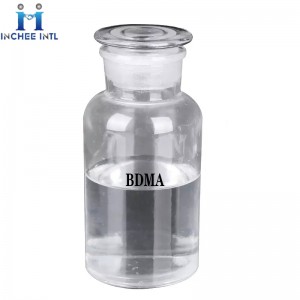-

Manufacturer Good Price N-VINYL PYRROLIDONE (NVP) CAS 88-12-0
N-VINYL PYRROLIDONE (N-Vinyl-2-pyrrolidone) is referred to as NVP, also known as 1-vinyl-2-pyrrolidone, N-VINYL PYRROLIDONE. N-VINYL PYRROLIDONE is a colorless or light yellow transparent liquid with slight odor at room temperature, easily soluble in Chemicalbook water and other organic solvents. Because N-vinylpyrrolidone can increase various physical and chemical properties of products.N-VINYL PYRROLIDONE is widely used: in radiation medicine, wood floor industry, paper or cardboard industry, packaging materials, screen ink industry, the use of NVP improves the physical properties of products.
N-VINYL PYRROLIDONE (NVP) is commonly used as a reactive diluent for radiation curing in UV-coating, UV-inks, and UV adhesives. It is used as a monomer to produce water soluble polyvinylpyrrolidone (PVP) with uses in pharmaceuticals, oil field, cosmetics, food additives & adhesives. It is used in the manufacture of copolymers with, for example, acrylic acid, acrylates, vinyl acetate and acrylonitrile and in the synthesis of phenolic resins.
CAS: 88-12-0
-

Manufacturer Good Price P-TOLUENESULFONYLISOCYANATE (PTSI) CAS 4083-64-1
P-TOLUENESULFONYLISOCYANATE (PTSI) is a single functional isocyanate. P-TOLUENESULFONYLISOCYANATE (PTSI) has high activity and can react with conventional diisocyanates, such as TDI and HDI, with water in polyols and solvents. The resulting carbamate does not increase the viscosity of the system. The disadvantage is that the toxicity of oxazolidine and other dehydrants is large; P-TOLUENESULFONYLISOCYANATE (PTSI) reacts with water to produce carbon dioxide and toluenesulfamide, so P-TOLUENESULFONYLISOCYANATE (PTSI) cannot be used directly in paint formulations and is generally used for pre-dehydration. To remove 1g of water in the solvent, about 12g of PTSI is theoretically required, but the actual amount should be higher than this.
CAS: 4083-64-1
-

Manufacturer Good Price Dimethylbenzylamine (BDMA) CAS:103-83-3
Dimethylbenzylamine (BDMA) is a colorless to light yellow liquid with an aromatic odor. Slightly less dense than water and slightly soluble in water. Flash point approximately 140°F. Corrosive to skin, eyes and mucous membranes. Slightly toxic by ingestion, skin absorption and inhalation. Used in the manufacture of adhesives and other chemicals.
CAS:103-83-3
-

Manufacturer Good Price CalciumAlumina Cement CAS:65997-16-2
CalciumAlumina Cement is cement with calcium calcium or calcium aluminum as its main mineral component. It is made of natural aluminum or industrial alumina and calcium carbonate (limestone) according to a certain proportion, which is made by burning or electric melt.
Ingredients and categories: CalciumAlumina Cement can be divided into ordinary aluminum calcium calcium cement (al2O3 53-72%, CAO 21-35%) and pure aluminum calcium cement (al2O3 72-82%, CAO 19-23 %) Two categories. Ordinary aluminum cement cement can be divided into low -iron type (FE2O3 <2%) and high -speed rail type (Fe2O37-16%). Low -rail -type aluminum -type calcium cement can be divided into alum soil cement (Al2O353 ~ 56 %, CAO 33-35%), aluminum -60 cement (al2O359%to 61%, CAO 27-31%), and low -calcium aluminum acid cement (Al2O3 65-70%, CAO 21 to 24%). Pure aluminum calcium cement can be divided into two types: Al2O3 72-78%) and ultra -high aluminum type (Al2O3 78-85%). In addition, there are fast and hard early strong aluminum calcium cement.CAS: 65997-16-2
-

Manufacturer Good Price PVB( Polyvinyl Butyral Resin) CAS:63148-65-2
Polyvinyl Butyral Resin(PVB) is a product that is contracted by polyvinyl alcohol and butadhyde under acid catalytic. Because PVB molecules contain long branches, they have good softness, low glass temperature, high stretching strength and anti -impact strength. PVB has excellent transparency, good solubility, and good light resistance, water resistance, heat resistance, cold resistance, and film formation. It contains functional groups that can perform various reactions such as acetylene -based saponification reactions, vinegarization of hydroxyl, and sulfonic acidization. It has high adhesion with glass, metal (especially aluminum) and other materials. Therefore, it has been widely used in the fields of manufacturing safety glass, adhesives, ceramic flower paper, aluminum foil paper, electrical materials, glass reinforcement products, fabric treatment agents, etc., and become an indispensable synthetic resin material.
PVB( Polyvinyl Butyral Resin) CAS:63148-65-2
Series:PVB( Polyvinyl Butyral Resin) 1A/PVB( Polyvinyl Butyral Resin) 3A/PVB( Polyvinyl Butyral Resin) 6ACAS: 63148-65-2






